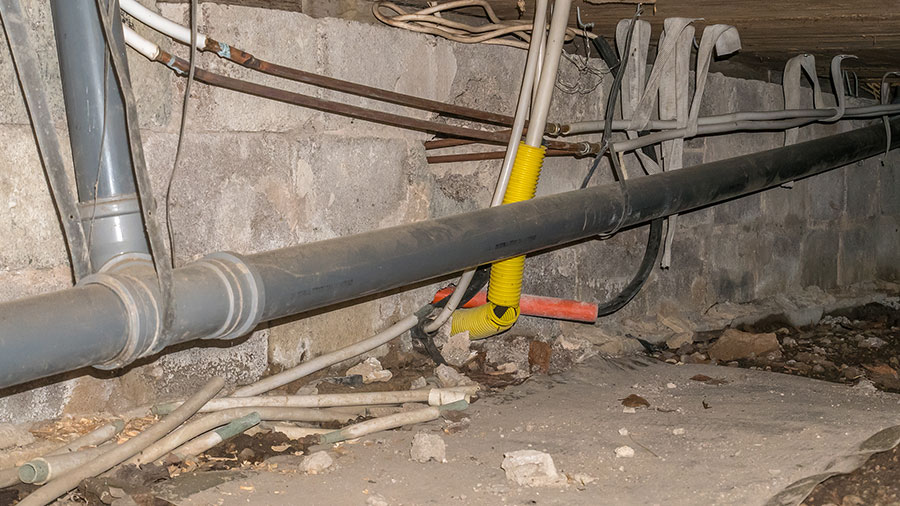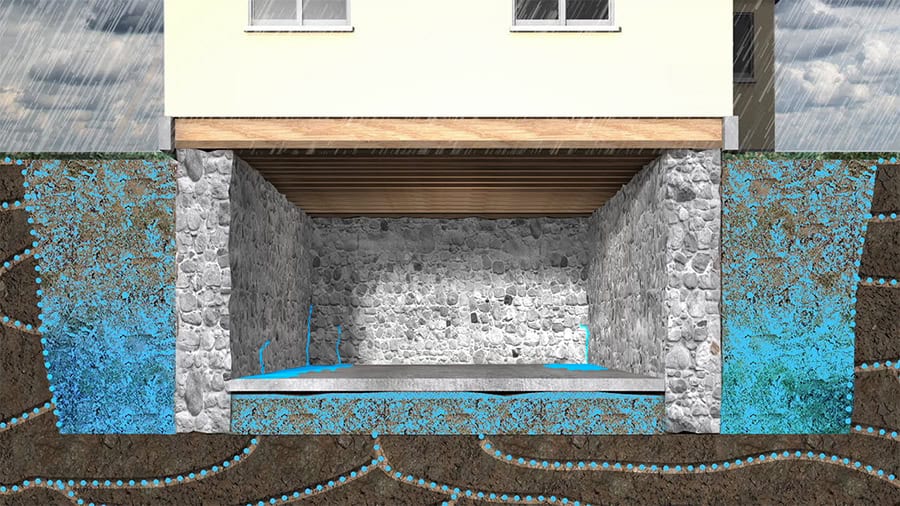Stone Foundation: Ways You Can Prevent Water Leaks

Share this Post
To prevent a water leak in a stone foundation, proper grading, sealant, mortar repair, proper ventilation, and a subfloor drainage system with a sump pump.
Table of Contents
The Purpose of a Stone Foundation
A stone foundation’s primary purpose is to keep out moisture and insulate a home from the cold. There are several types of foundations found in houses. A full basement above or below ground, a slab on the main floor, or a crawlspace. The type of foundation depends on the house design, location, climate, and soil moisture.
An older home from the pre-war era is likelier to have a stone foundation. Homes constructed before World War One have a stone foundation. After WWI, they began to build foundations with concrete blocks or poured concrete. These materials became popular and more widely used than stone because of their accessibility and inexpensive costs.
Types of Stone Foundation
Rubble
Flat stones that are of different sizes and shapes. Rubblestone foundations, in most cases, lack a binding agent. Therefore condensation can make its way into the foundation.
Fieldstone
These are foundational stones of similar sizes. This foundation is without a binding agent and is placed together based on the stone’s cut.
Dressed Stone
Commonly referred to as cut stones are bound together with mortar or concrete. This procedure provides access to water to the interior of the foundation.
It doesn’t matter which type of stone foundation is in a home; somebody should do additional waterproofing as a precautionary measure to prevent water from leaking through the stone foundation.
As they age, the issue with stone foundations is that signs of water seepage may begin to appear. While stone walls are known for their durability and strength, most of these foundations are not waterproof. Problems can quickly reveal themselves when the house is not leveled or improperly built, which results in wall cracking, bowing, and water leakages.

Importance of Waterproofing The Foundation
Waterproofing protects more than just the structural support of a foundation. Other issues can arise from water leaking through the stone foundation.
Growth of mold: A wet basement is a perfect environment for mold to thrive and grow.
Pungent odor: The combination of mold, standing water, and pests can create a strong foul smell.
Dampness and flooding: If dampness or flooding in the basement after it rains, it could be a telltale sign that the foundation is weak.
When water begins leaking through the basement foundation walls, it signifies that the mortar joints are damaged.
With that in mind, it is necessary to waterproof stone walls to form a barrier against water. If water cannot seep through the foundation, the risk of these issues is eliminated. People often ignore the signs that water is leaking through the basement foundation and later claim the leak came out of nowhere.
Some signs are present to indicate that water could leak through the foundation.
You need waterproofing if you see these signs in a wet basement:
- Unpleasant odors coming from the basement
- Rotting wood, standing water, or wet areas of the floor in the basement
- Damp and discolored stones
- Bubbling, cracking, peeling paint or wallpaper on surfaces

What Causes a Wet Basement?
Several things contribute to a wet basement:
The soil around the home’s foundation is damp and expands, forcing pressure on the foundation and causing water to enter through cracks, gaps, and other openings, such as pipes and windows.
Water collects in the soil surrounding the home’s foundation, placing pressure on the foundation walls. The pressure causes the foundation to shift, crack mortar joints, and water seeps in.
Stone Foundation Waterproofing Solutions
When the home’s foundation needs waterproofing, the options are interior or exterior waterproofing. Here are the two waterproofing procedures in more detail:
Interior Waterproofing
There are many waterproofing products and installation service companies, but there is one common goal. The goal is to reroute water out of the basement and away from the house.
Unfortunately, too many companies are installing ineffective systems for a quick buck. The best way to remove the water is by installing a drainage system below the slab floor next to the footer.
This drainage system uses pipe(s) packed in stone to catch leaks or groundwater penetrating the foundation. A combination of a drainboard, a thick poly vapor barrier, and 3.5+ inches of concrete replace the perimeter slab floor along the basement’s perimeter.
Groundwater is collected in the pipe and gets directed to a sump basin. Inside the basin is a sump pump. The pump sucks in water and pumps it out and away from the basement and home, respectively.
Exterior Foundation Repair
An exterior foundation waterproofing repair requires more work than the interior waterproofing method and, in all cases, is more expensive. It has a similar purpose to stopping water from penetrating the foundation.
The first step in exterior stone foundation repair is to excavate around the perimeter of the home’s foundation. Excavating requires the removal of sections of landscaping, walkways, decking, and driveways. It can be very disruptive.
Once the exterior foundation walls and footer are exposed, it’s time to remove the old mortar. Fresh mortar and a waterproof membrane are applied around the exterior walls.
The drain tile (rigid or flexible pipe) is installed in the ground around the house. The drain tile is packed in stone, and loose dirt is placed on top of the stone. The groundwater is directed away from the foundation before penetrating the foundation walls.
Exterior waterproofing systems don’t hold up in the long run. That is why contractors rarely, if ever, offer a warranty for more than ten years. A combination of silt clogging, root intrusion, and disruptions caused by wildlife and insects can and will put your foundation in jeopardy again.
Conclusion
Stone foundations are reliable and durable. Many homes with 500-year-old foundations still hold firm today, yet their biggest weakness is water seepage. Waterproof your basement with a proven subfloor system that can discharge groundwater from your house.
Don’t sacrifice the structural integrity of your foundation. Mold and mildew can affect your health and make life uncomfortable in your home. It is up to you. Make it last another 500 years.
Schedule a free, no-obligation inspection and quote at no cost.